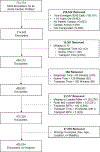Prehospital time for patients with acute cardiac complaints: A rural health disparity
- PMID: 34871845
- PMCID: PMC9029257
- DOI: 10.1016/j.ajem.2021.11.038
Prehospital time for patients with acute cardiac complaints: A rural health disparity
Abstract
Objective: Delays in care for patients with acute cardiac complaints are associated with increased morbidity and mortality. The objective of this study was to quantify rural and urban differences in prehospital time intervals for patients with cardiac complaints.
Methods: The ESO Data Collaborative dataset consisting of records from 1332 EMS agencies was queried for 9-1-1 encounters with acute cardiac problems among adults (age ≥ 18) from 1/1/2013-6/1/2018. Location was classified as rural or urban using the 2010 United States Census. The primary outcome was total prehospital time. Generalized estimating equations evaluated differences in the average times between rural and urban encounters while controlling for age, sex, race, transport mode, loaded mileage, and patient stability.
Results: Among 428,054 encounters, the median age was 62 (IQR 50-75) years with 50.7% female, 75.3% white, and 10.3% rural. The median total prehospital, response, scene, and transport times were 37.0 (IQR 29.0-48.0), 6.0 (IQR 4.0-9.0), 16.0 (IQR 12.0-21.0), and 13.0 (IQR 8.0-21.0) minutes. Rural patients had an average total prehospital time that was 16.76 min (95%CI 15.15-18.38) longer than urban patients. After adjusting for covariates, average total time was 5.08 (95%CI 4.37-5.78) minutes longer for rural patients. Average response and transport time were 4.36 (95%CI 3.83-4.89) and 0.62 (95%CI 0.33-0.90) minutes longer for rural patients. Scene time was similar in rural and urban patients (0.09 min, 95%CI -0.15-0.33).
Conclusion: Rural patients with acute cardiac complaints experienced longer prehospital time than urban patients, even after accounting for other key variables, such as loaded mileage.
Keywords: Acute coronary syndrome; Chest pain; Disparity; Emergency medical services (EMS); Prehospital; Rural; Urban.
Copyright © 2021 Elsevier Inc. All rights reserved.
Figures
Similar articles
-
Disparities in Emergency Medical Services Time Intervals for Patients with Suspected Acute Coronary Syndrome: Findings from the North Carolina Prehospital Medical Information System.J Am Heart Assoc. 2021 Aug 3;10(15):e019305. doi: 10.1161/JAHA.120.019305. Epub 2021 Jul 29. J Am Heart Assoc. 2021. PMID: 34323113 Free PMC article.
-
Prehospital Time Disparities for Rural Patients with Suspected STEMI.Prehosp Emerg Care. 2023;27(4):488-495. doi: 10.1080/10903127.2022.2061660. Epub 2022 Apr 27. Prehosp Emerg Care. 2023. PMID: 35380911 Free PMC article.
-
Emergency Medical Services Time Intervals for Acute Chest Pain in the United States, 2015-2016.Prehosp Emerg Care. 2020 Jul-Aug;24(4):557-565. doi: 10.1080/10903127.2019.1676346. Epub 2019 Nov 6. Prehosp Emerg Care. 2020. PMID: 31580176
-
Community socioeconomic and urban-rural differences in emergency medical services times for suspected stroke in North Carolina.Am J Emerg Med. 2023 Jan;63:120-126. doi: 10.1016/j.ajem.2022.10.039. Epub 2022 Nov 2. Am J Emerg Med. 2023. PMID: 36370608 Free PMC article.
-
Factors Impacting Patient Outcomes Associated with Use of Emergency Medical Services Operating in Urban Versus Rural Areas: A Systematic Review.Int J Environ Res Public Health. 2019 May 16;16(10):1728. doi: 10.3390/ijerph16101728. Int J Environ Res Public Health. 2019. PMID: 31100851 Free PMC article.
Cited by
-
Assessing variations in care delivered to rural out of hospital cardiac arrest patients in the interfacility transfer setting.J Am Coll Emerg Physicians Open. 2024 Oct 21;5(5):e13330. doi: 10.1002/emp2.13330. eCollection 2024 Oct. J Am Coll Emerg Physicians Open. 2024. PMID: 39435328 Free PMC article.
-
Using wastewater to overcome health disparities among rural residents.Geoforum. 2023 Aug;144:103816. doi: 10.1016/j.geoforum.2023.103816. Epub 2023 Jun 26. Geoforum. 2023. PMID: 37396346 Free PMC article.
-
Prehospital Time Interval for Urban and Rural Emergency Medical Services: A Systematic Literature Review.Healthcare (Basel). 2022 Nov 29;10(12):2391. doi: 10.3390/healthcare10122391. Healthcare (Basel). 2022. PMID: 36553915 Free PMC article. Review.
-
Ambulance service recognition of health inequalities and activities for reduction: An evidence and gap map of the published literature.Br Paramed J. 2024 Jun 1;9(1):47-57. doi: 10.29045/14784726.2024.6.9.1.47. Br Paramed J. 2024. PMID: 38946737 Free PMC article.
References
MeSH terms
Grants and funding
LinkOut - more resources
Full Text Sources
Medical



